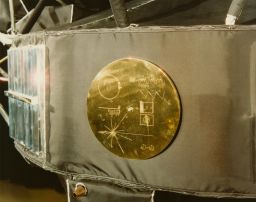Story highlights
NASA's Voyager "golden record" features the sounds of Earth
The recording is meant for extraterrestrials
Call it “Music for Extraterrestrials” – now available for humans.
In 1977, NASA sent two probes, Voyager 1 and Voyager 2, into the cosmos. Both were equipped with “golden records,” phonograph recordings (how quaint that seems now!) of Earth sounds, along with images of human existence and scientific basics. Yes, the package also included a cartridge and needle.
A team led by Carl Sagan oversaw the content.
The audio portion of the golden records included music from Beethoven, Mozart, Blind Willie Johnson and Chuck Berry, as well as a message from then-President Jimmy Carter. (The Beatles’ “Here Comes the Sun” was intended for inclusion, but the idea was allegedly shot down by EMI, the group’s label.)

NASA has now uploaded the contents of the golden record to SoundCloud so humans – many of whom weren’t alive when Voyager 1 was launched into the universe – can hear what the aliens would hear.
The space agency started releasing its audio to SoundCloud last year.
It’s not the first unusual item we’ve sent into space:
Legos
In 2011, NASA launched the orbiter Juno, with the intent to study the planet Jupiter. It was equipped with Legos of Galileo – who studied the planet and its moons – and the Roman gods Jupiter and Juno. The orbiter will reach the gas giant next July.
Clyde Tombaugh’s ashes
Tombaugh, who discovered Pluto in 1930, may not have lived long enough to see his discovery up close – but an earthly remnant, some of his ashes, are on the New Horizons spacecraft, which came within 7,800 miles of the dwarf planet in mid-July.
“When he looked at Pluto, it was just a speck of light,” Annette Tombaugh, his daughter, said this year. “To actually see the planet that he had discovered and find out more about its atmosphere, find out more of what it is and actually get to see the moons of Pluto, he would have been astounded.”
Playboy magazine
Some mischievous astronauts on Apollo 12 incorporated some of the magazine’s photos in checklists for the mission. Also included: the 1967 centerfold of Playmate DeDe Lind.
Coke and Pepsi
After Coca-Cola spent a quarter-million dollars inventing a can that could work without gravity for use on the space shuttle, Pepsi wanted in as well, so NASA let them both (and any other soft drink) take part. In 1985, four cans of Coke and four cans of Pepsi went up in the Challenger. The astronauts were unimpressed.
A lightsaber
A 2007 mission of the space shuttle Discovery included an addition from George Lucas: the prop lightsaber used by Luke Skywalker in “Return of the Jedi.”
Other “Star Wars” items have also been into space, astronaut Jim Reilly said in a NASA news release.
“Toy mementos, things like a ‘Star Wars’ toy that might have meant something in their life, so there are any number of things that might be just a little out of the ordinary,” he said.
Meanwhile, Voyager 1 continues its earnest mission. The craft is currently more than 12 billion miles away.
It still sends messages back, however – though its signal takes more than 17 hours to make the trip. If extraterrestrials should ever discover the probe and the golden record, it could be a while before we know.
However, if an old joke from “Saturday Night Live” holds true, the aliens will want more of one thing.
Noting that NASA had received a message that proved there was intelligent life elsewhere in the universe, a sketch observed that the aliens had transmitted four words: “Send more Chuck Berry.”
























